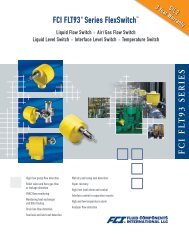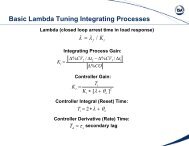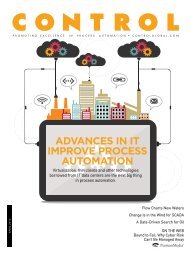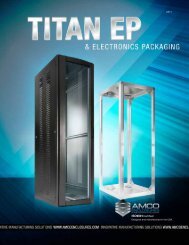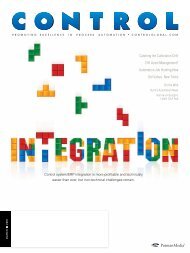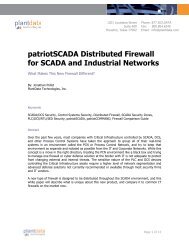April 2011 - Control Global
April 2011 - Control Global
April 2011 - Control Global
Create successful ePaper yourself
Turn your PDF publications into a flip-book with our unique Google optimized e-Paper software.
O N T H E B U S<br />
Attack of the Mutant Chicken Foot!<br />
A few months after start-up, our facility needed to add an alternative purge medium<br />
for a process vessel. Along with a flow loop, we needed a couple trios of new doubleblock-and-bleed<br />
actuated valves in a spot about 90 feet from grade. So did we need<br />
to run nine twisted pairs (or more—up to 20 for conventional on-off valves) all the way<br />
john Rezabek<br />
contributing Editor<br />
jrezabek@ispcorp.com<br />
down to grade? We found we could just extend<br />
an existing fieldbus segment from an instrument<br />
at that level—so maybe 25 feet of light<br />
conduit on a platform were needed instead of<br />
100 feet of 2-in. down the side of a structure.<br />
Why hadn’t we done this from the start? Our<br />
original “chicken foot” network was grafting<br />
eight toes on one of its toes.<br />
In recent issues, we’ve explored how bus<br />
technologies create new challenges for end users’<br />
Engineer, Procure, Construct (EPC) consultants<br />
and systems integrators. Bus technologies<br />
provide a standardized infrastructure,<br />
allowing smart devices to integrate happily<br />
with the host DCS and one another. End users<br />
want this because they see a path to improved<br />
control, process availability and risk/asset management.<br />
But for the EPCs, it’s disruptive.<br />
Bus topology—the ability of multiple devices<br />
to share the same two conductors on a network<br />
or “segment”—is one of the disruptive forces.<br />
We have deployed networks elsewhere, so why<br />
would fieldbus cause consternation?<br />
The challenge is this: process plants have<br />
hundreds or thousands of devices distributed<br />
to scores or hundreds (or more) segments. In<br />
the point-to-point world, there is a one-to-one<br />
relationship between device, single-pair cable,<br />
multi-pair cable “pair,” field JB terminals, marshalling<br />
terminals, scatter wire, all the way to<br />
the I/O processor terminations, so much so that<br />
the whole process can be largely automated.<br />
Designers and engineers work from a database,<br />
whose fields then populate loop drawing templates,<br />
junction box drawings and termination<br />
schedules.<br />
With fieldbus, all the one-to-one relations of<br />
the old world are scrambled: devices can have<br />
multiple roles; home-run cables can serve as<br />
few as two devices or as many as 32; and the<br />
rules for grouping devices are anything but random<br />
and can be crucial to a successful project.<br />
Tools do exist, such as Intergraph’s SmartPlant<br />
INTools CAD products, but they require a new<br />
level of training and effort that was previously<br />
unimportant or automated. So have some compassion<br />
for your EPC and simplify.<br />
For your first fieldbus job, consider a simple<br />
“chicken foot” or “star” topology. By standardizing<br />
on six segments (~72 devices) per field<br />
junction box, your install will look and feel<br />
close to conventional, but you’ll be running<br />
some bigger conduits and raceways. It will look<br />
just like conventional point-to-point from the<br />
JB to the field. If a certain device needs to move<br />
from segment “A” to segment “B” late in the<br />
job, there’s an increased chance they’ll be in<br />
the same JB. While less optimal for the project<br />
in the CAPEX phase, the strategy lends itself<br />
well to future expansion. In this scenario,<br />
the client can still add to the installed “chicken<br />
foot” as every fieldbus node can become an “expansion<br />
point” for future additions.<br />
Users with great confidence in their segment<br />
loading and their team’s fieldbus savvy may<br />
choose what many consider an “optimum” topology,<br />
what I call the “mutant” chicken foot.<br />
Spurs—“toes” if you will—grow on the trunk<br />
wherever needed. The trunk strings these clusters<br />
together as a single pair, so conduit size is<br />
minimized. If local codes allow, using “basket<br />
trays” can be more forgiving for late changes<br />
and future modifications. Physical layer suppliers<br />
such as Pepperl+Fuchs, Relcom, Turck<br />
and Phoenix Contact have some nice modular<br />
hardware to accommodate these multi-drop hybrid<br />
schemes. Every project will have its unique<br />
mix of experience and confidence on both the<br />
client and consultant sides. Making discrete topology<br />
choices in light of your team’s strengths<br />
and challenges can help ensure a smoother and<br />
less stressful journey.<br />
We have deployed<br />
networks elsewhere—so<br />
why<br />
would fieldbus<br />
cause<br />
consternation?<br />
A p r i l / 2 0 1 1 www.controlglobal.com 23






